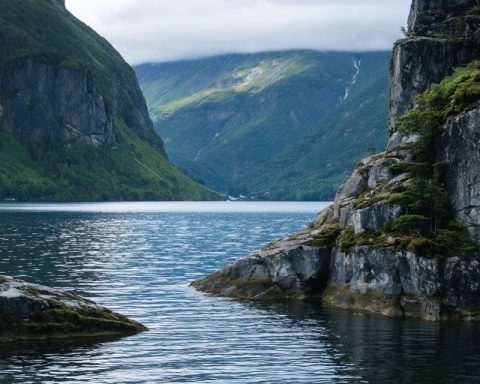- Australia is renowned for its stunning landscapes, diverse wildlife, and rich cultural history.
- The Outback and sites like Uluru offer spiritual and awe-inspiring experiences rooted in Indigenous heritage.
- Coastal cities such as Sydney and Melbourne combine modernity with access to stunning natural attractions like pristine beaches and the Great Barrier Reef.
- The Great Barrier Reef is a spectacular underwater ecosystem, home to diverse marine life and vibrant coral gardens.
- Beyond the coast, Australia’s rainforests and mountain ranges host unique biodiversity and endemic species.
- The natural beauty and cultural stories of Australia highlight the importance of conservation and responsible exploration.
- Australia invites nature lovers to explore its treasures, urging protection of its fragile yet splendid ecosystems for future generations.
Venture into the land where kangaroos leap and koalas nap, and you’ll discover more than meets the eye. Australia, renowned for its stunning landscapes and diverse wildlife, offers an unforgettable journey through nature’s wonders.
Picture this: the sun setting over the vast, red expanse of the Outback, where ancient rock formations like Uluru rise majestically. The heart of Australia beckons with tales as old as time, woven by the Indigenous peoples who have lived here for thousands of years. Their rich cultural history, etched into the land and sky, creates an atmosphere that’s both spiritual and awe-inspiring.
Coastal cities like Sydney and Melbourne offer a contrasting backdrop of modernity. Here, skyscrapers gleam in the daylight, yet a short drive leads you to pristine beaches where surfers ride the waves. The Great Barrier Reef, a vibrant underwater spectacle, stretches over 2,300 kilometers and provides a sanctuary for myriad marine species. Its colorful coral gardens form breathtaking vistas, a diver’s paradise that showcases nature’s artistry.
Australia’s biodiversity doesn’t end at the shore. It extends to the dense rainforests of Daintree and the rugged peaks of the Blue Mountains. These ecosystems boast an incredible array of plants and animals, many found nowhere else on Earth. Imagine walking through lush, green canopies where exotic birds flit above and curious marsupials peek from the underbrush.
Yet, the lure of Australia’s wildlife is not merely visual. Enthusiastic conversations between the cries of kookaburras and the gentle rustling of eucalyptus leaves form a symphony that embodies the wild spirit of this continent. Every step taken in these lands tells stories of adaptation and survival in one of the planet’s most unique ecological niches.
The takeaway from Australia is clear: embrace the diversity of our natural world and the cultures that thrive within it. Protecting and respecting these wild spaces and the stories they hold is essential. As Australia exemplifies, nature’s beauty is matched by its fragility, urging us to act responsibly so future generations can also revel in its wonders.
Australia stands as a testament to the splendor and resilience of the natural world, inviting travelers and nature lovers to explore its treasures, leaving them with memories to cherish and a newfound respect for our planet’s incredible variety.
Unlocking Australia’s Hidden Gems: Adventures Beyond the Iconic Landmarks
Exploring Australia’s Cultural and Natural Tapestry
Australia’s landscape is a vibrant mosaic of natural wonders and cultural depth that goes far beyond its more famed attractions. While the article provides an enchanting introduction to its iconic allure, there’s more to uncover in this expansive nation. Delve deeper to discover facts, tips, and insights designed to enrich your Australian exploration.
Indigenous Heritage and Cultural Tourism
– Ancient Traditions: Australia boasts one of the oldest continuous cultures in the world. Indigenous Australians, primarily Aboriginal and Torres Strait Islander peoples, have rich oral traditions and spiritual connections to the land. Sites like Kata Tjuta and Kakadu National Park host rock art dating back thousands of years, offering glimpses into these vibrant histories. Visit during local cultural festivals for immersive experiences.
– Preservation Efforts: Cultural tourism in Australia is growing, with efforts to preserve Indigenous languages and traditional practices. The Aboriginal Cultural Centre at Uluru is a hub for learning about ancestral heritage.
Ecological Diversity and Conservation
– Unique Ecosystems: Beyond the Daintree Rainforest and Blue Mountains, Australia is home to environments as varied as the arid Pinnacles Desert and the lush Tasmania Wilderness Reserve. The biodiversity here is both a treasure and a challenge, as many species and habitats are threatened by climate change.
– Marine Life and Sustainability: The Great Barrier Reef is a key case study for marine conservation. While coral bleaching remains a significant issue, efforts such as the Reef 2050 Long-Term Sustainability Plan aim to mitigate impacts. Visitors can join eco-conscious tours, supporting rehabilitation projects targeting this living wonder.
Travel Tips and Adventure
– Journey Through the Outback: For an authentic adventure, venture into the heart of Australia by driving the Stuart Highway or boarding The Ghan train. These routes traverse dynamic terrains and offer stops at places like Coober Pedy, an opal-mining town with underground dwellings.
– Urban Meets Nature: Cities like Melbourne are hubs of multicultural vibrancy, known for their art scenes and coffee culture. A stroll through Melbourne’s laneways reveals hidden art galleries, while its proximity to the Yarra Valley entices wine enthusiasts.
Real-World Use Cases and Projections
– Eco-Tourism Trends: Australia is a leading destination for eco-tourism, balancing tourism growth with sustainability. The industry is expected to see an increase in eco-travel, with more travelers seeking authentic, low-impact experiences.
– Wildlife Encounters: With nearly 90% of its wildlife species found nowhere else, Australia’s natural heritage offers opportunities for encounters with animals like platypuses and Tasmanian devils. Awareness campaigns continue to emphasize the importance of respecting wildlife habitats.
Practical Tips for Your Journey
– Planning and Timing: The best time to visit is during the spring (September to November) or autumn (March to May) when the climate is milder, making it ideal for outdoor activities.
– Learn Locally: Support Indigenous businesses by seeking out guides from local communities who offer storytelling and insights into the natural world.
Conclusion: Preserve and Experience
Australia invites you to witness its breathtaking vistas and layers of culture while promoting a conscious interaction with its pristine environments. As a traveler, embracing responsible travel practices ensures the longevity of these shared natural treasures.
Discover the allure of Australia beyond the surface. Cultivate a journey filled with respect for nature and its legacy, leaving with more than just memories. Embrace the journey by visiting official tourism sites for guidance: Australia.




















